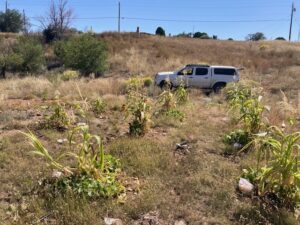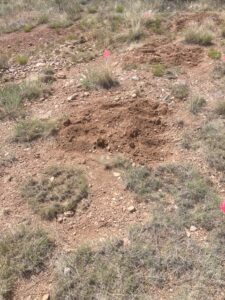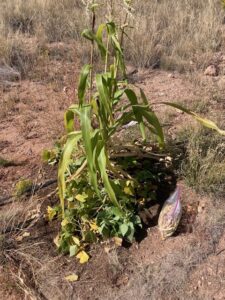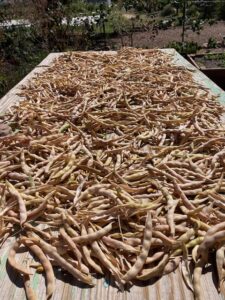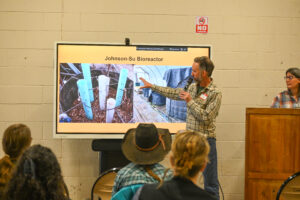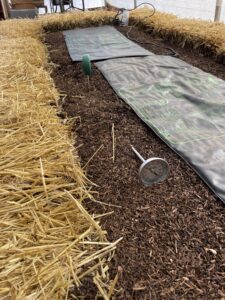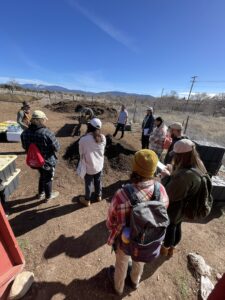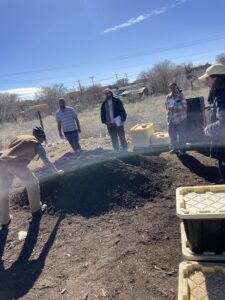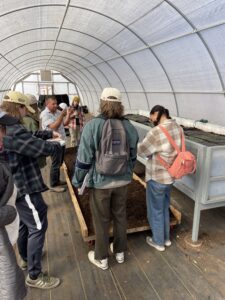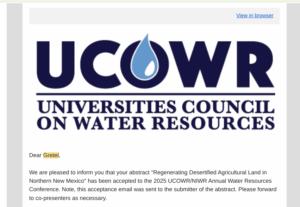Progress report for FW23-430
Project Information
We propose to test how efficiently we can regenerate desertified soil and grow productive crops, 1) using different composts (including inoculated biochar and composts created in Johnson-Su bioreactors), 2) combined with drought-adapted indigenous and landrace plant species, and 3) using a variety of traditional and modern water-wise techniques to minimize water usage. Our goal is to create a replicable model for agricultural resiliency designed to be effective in drought-prone, high desert settings. We will use as our test plot a one-acre piece of damaged land, most recently used as a sand mine, but previously farmed by indigenous and Hispanic farmers for hundreds of years. This test plot is managed by Reunity Resources Farm, a closed-loop regenerative urban farm located about 5 miles west of the center of Santa Fe, New Mexico.
Reunity Resources’ mission includes educating the public about regenerative farming, climate change, and composting. It operates a large-scale commercial composting operation (which collects food waste from some 30 local restaurants, the Santa Fe School System, and ~450 local households). We will leverage Reunity’s current educational programming – held onsite for youth and adults, in the local schools, and in outreach to the larger community -- to disseminate the results of our experiments. We will also leverage an $8 million Santa Fe County project to complete the last section of the popular Santa Fe River Walk multi-use path to the San Ysidro Crossing, where Reunity is located. The River Walk, scheduled to be completed in 2024, runs alongside Reunity Resources and the test plot. The influx of new visitors to Reunity will provide us with rich opportunities to educate the public about how regenerative farming techniques can be a critical tool in ensuring a supply of fresh, locally-grown produce in the face of supply chain disruptions due to climate change.
Our project will use a powerful tool to both combat climate change and increase the availability of locally-grown produce: bringing marginal and desertified land into productive agricultural use by employing regenerative farming practices to build healthy, drought-resistant soil. Through this process, we are combatting climate change by sequestering substantial amounts of carbon in the soil, and diverting food and farm waste from landfills by composting them on-site at the farm. (e.g. Project Drawdown; MacDonald 2010)
Our research objective is to explore how successfully we can regenerate desertified soil and grow productive, profitable crops. As proof of concept, the test plot sits on land adjacent to Full Circle Farm, which was brought into production in 2021 as a joint project between Reunity Resources, Santa Fe County, and three local non-profits which focus on training BIPOC youth. The land was successfully put into production using composts produced at Reunity; a systematic approach could not be utilized for a variety of practical reasons. On the test plot we propose to use in this project, a variety of experiments will be carefully designed and executed so measures of soil regeneration (e.g. carbon content, fungal:bacterial colony ratios, water retention capabilities, etc.) and the relative success of different plant species can be systematically quantified.
Our educational objective is to expand our current educational and outreach programs, with a focus on providing a replicable model to regenerate land and grow plants most likely to survive an increasingly hot and dry climate. We will provide both passive education -- for example, placing interpretive signs along the new River Walk opening in 2024 (which will run adjacent to the test plot) so visitors can learn about regenerative farming as practiced in a high-desert environment -- and more structured educational programs, such as those currently provided by Reunity for children and adults, and including a collaboration with Santa Fe Community College’s Sustainability program. We also intend to publish at least one peer-reviewed paper resulting from our research, and present our research findings to our network of organizations focused on sustainability, and at conferences on sustainable agriculture.
| PROJECT TIMELINE | |||||||||
| ACTIVITIES | Spring 2023 | Summer 2023 | Fall 2023 | Winter 2023-4 | Spring 2024 | Summer 2024 | Fall 2024 | Winter 2024-25 | Spring 2025 |
| Producer & Technical Advisor Finalize Initial Test Plot Design, Soil & Plant Testing Schedule | X | ||||||||
| Producer & Technical Advisor Finalize Test Plot Design, Soil & Plant Testing Schedule Based on Yr 1 Results | X | ||||||||
| Test plots laid out; compost applied; seeds planted | X | X | |||||||
| Baseline & Post-Harvest Soil Testing | X | X | X | ||||||
| Plant Tissue & Biomass Testing | X | X | |||||||
| Results Analyzed and Reports, Educational Materials, and Publications Written | X | X | X | X | |||||
| Preliminary and Final Results Presented at Conferences and Workshops | X | X | X | X | X | X | |||
| On-Farm Educational Activities (formal and informal) Focused on Test Plot | X | X | X | X | X | ||||
| Curriculum Materials Developed for Multiple Audiences (children, adult learners, college-level) | X | X | X | ||||||
| White papers, blog posts, etc. posted online (e.g. through soil health/regenerative farming orgs, Extension Connect, etc) | X | X | X | X | X | X | |||
Cooperators
- - Technical Advisor
Research
Reunity proposes to use a desertified one-acre piece of land as a test plot on which we will grow multiple varieties of locally adapted, drought-resistant crops using a variety of compost types. We will also test watering strategies, including dry-land techniques informed by local indigenous practices. While this plot of land was farmed for centuries by indigenous agriculturalists and Hispanic colonists and their descendants, it was most recently the site of a sand mining operation. We propose to experiment with different composts to increase SOM. We will focus on composts created in Johnson-Su Bioreactors, which are rich in fungal communities and show promise in substantially boosting agricultural yields. The efficacy of Johnson-Su compost is somewhat controversial, as to date no peer-reviewed research has been published, despite experiments undertaken at various sites with varying results. Several SARE projects are currently evaluating Johnson-Su bioreactor compost and other fungal inoculants (for example, FW20-371, which seeks to regenerate mountain meadow pastures in Colorado using Johnson-Su compost; GW21-224, which is evaluating fruit yields on a California dry farm using fungal inoculants; FW22-404, which involves an on-field trial of cover cropping and Johnson-Su inoculants.) No projects we are aware of (including those supported elsewhere) are testing the use of fungal inoculants on desertified soil in a low-water or dry-farming environment with drought-tolerant plants, an important experiment for New Mexican farmers.
Objective #1 – Compare Plant Productivity Using Different Compost Inputs
Using a split plot design (modified to eliminate randomization, as the test plot is uniformly desertified; Altman and Krzywinski, 2015), test at least 8 types of compost mixes and delivery methods. For example: 1) conventional compost made with Reunity’s aerated static pile system, 2) Johnson-Su bioreactor compost, 3) vermicompost, 4) conventional plus Johnson-Su composts, 5) Johnson-Su compost and vermicompost, 6) biochar inoculated with Johnson-Su compost buried 2 feet below surface, 7) biochar inoculated with Johnson-Su compost buried 1 foot below surface, 8) Johnson-Su compost applied to soil surface. We will work with our technical advisor, Dr. Follingstad, to refine and implement this design. Dr. Follingstad will also work with us to design our soil testing and data collection protocols. Reunity currently tests soil and plant tissue 1x – 2x per year; the existing protocol may be modified for the test plot.
A variety of plants will be grown under the 8 or more composting conditions: commercial seeds currently grown at Reunity Farms will be compared to their drought-adapted heirloom counterparts. Heirloom and landrace (locally adapted) seeds, many of which are currently being grown at the adjacent Full Circle Farm, will be obtained from local indigenous communities and the Tesuque Farm seed bank (the largest indigenous seed bank in New Mexico, https://tesuquepueblofarm.weebly.com/about.html), or from Native Seed SEARCH, a non-profit based in Tucson which specializes in conserving heirloom seeds adapted to drought conditions. https://www.nativeseeds.org/
Objective #2 – Study/Determine Water Requirements
We will test how the above compost and plant species combinations perform in a variety of watering conditions: spot irrigation (as used at Reunity Farms), reduced irrigation (as used at Full Circle Farm), and dryland farming. The latter test will include designing test plots which make use of channeled summer monsoon rains, as well as traditional (e.g. cobble) and modern mulches and Zuni-style waffle gardens. Traditional Zuni farming makes use of rainfed fields and alluvial fans, designing check dams and other physical features to channel, capture, and retain water during intense monsoon rainfalls. As our summer monsoon is unpredictable, with intense rains that can be destructive, experimenting with indigenous water harvesting techniques is an important experiment.
Emily Arasim, a native of Tesuque Pueblo, said of her community’s heirloom seeds and the rapidly changing climate: "We have seeds that have been around for 6,000 years that have been cultivated generation by generation by our Pueblos that can handle these crazy summers we get. And that's going to be increasingly important for the whole world as we face these things." (Egolf-Romero 2017) Chemist and farmer Loretta Sandoval of Dixon, NM tested landraces versus hybrid peppers on her farm, and noted their ability to break dormancy and germinate more quickly than hybrids. This is critical for survival in a desert climate in which the summer monsoon season is relatively short; in New Mexico it usually starts in late June. It has been noted that Zuni traditional farmers hold off planting certain species until it rains, which gives these crops a short time to mature; we will observe germination times in our test plots. Sandoval noted the landraces’ drought resistance: “Last summer, which was the hottest recorded New Mexico summer in history, I went seven weeks without watering my landraces and they were fine… they weren’t even wilting, and it was over 100 degrees every day.” (Egolf-Romero 2017). We expect our findings will mirror Sandoval’s – that is, modern plant varieties will be more productive in ideal conditions (i.e. with irrigation), but traditional plants will prove to be more resilient and productive in the drier and unpredictable conditions that better represent the future of agriculture in the Southwest.
Objective #3 – Study Soil Health Metrics
Periodic testing of plant tissue and soil will be performed to determine the health of crops, which amendments to the soil are required, and the soil’s organic matter content. Baseline and subsequent periodic testing will determine how quickly organic matter can be increased in the desert soil, and how SOM levels affect the productivity of the plants we are testing. Unamended desert soil may contain about .5% carbon or less, and the maximum is ~10% in wetland and peat forest regions, so there is much potential for improving desertified soils and increasing its ability to sequester carbon. (MIT Climate Portal) As mentioned previously, Reunity Resources regularly performs seven soil and plant tests: water retention, water percolation, soil carbon, soil fungal to bacterial ratio, soil salinity, root-fruit-shoot biomass, and seed germination rates. Dr. Follingstad will work with Reunity staff to determine if additional types of tests may be needed, as well as determine optimal frequency of testing.
Research Outcomes
We were able to collect our first growing season of data in the following areas: germination rate, harvest weight and volume, soil moisture, soil biology, soil microbiology, soil physical, and soil infiltration. Some interesting patterns may be emerging, but since a farming season has many variables beyond the experimental controls (temperatures, winds, precipitation etc.), multiple seasons of data are important to make solid recommendations. Soil moisture and infiltration are two data points we will hone in on for the 2025 season.
Education and Outreach
Participation Summary:
We have been in a planning phase, coordinating with our partners at Three Sisters Collective, Communities in Schools, the Santa Fe Indian School and Santa Fe Public Schools to schedule our on-site work together over the course of the growing season. We are working with a committee of teachers from various grade levels at SFPS to create curricular materials that align with the state core requirements across grades. We have also built engagement with this project into our summer farm camp curriculum for our "Farm and Forest" cohort, with students ages 11-14.
We have hosted workshops and trainings with soil science students from the University of NM in Albuquerque and the United World College about the types of compost we create on site and their potential benefits. Under the guidance of Dr. Follingstad, we are developing and dialing in our split plot design and data points.
In fall of 2024 and spring of 2025, we hosted 3 more hands-on workshops, including the Ortiz Middle School science classrooms, the Santa Fe High AP Environmental Science classroom and the United World College Sustainability Cohort.
While we are largely still planning and pre-season, we have had great results with on-site, hands-on field trips for college students. We had a high level of engagement in small group settings (6-10 students with one composting professional/educator) about the different types of compost we produce and their potential applications and benefits. Presenting at a conference to other farmers and ranchers, we were limited to slide decks, but found that frequent questions for audience participation increased engagement.
The Educational components of this project are truly blossoming, and we have educated over 90 youth on soil data collection practices and comparative analysis techniques. We are now preparing the beds for planting and will deepn this work for another season. Our Ph.D supervisor has submitted an abstract and been accepted to present at the Universities Council on Water Resources in June, to present our in-progress work to an audience of professionals.
Education and Outreach Outcomes
We will be developing a brief online learning module (slides or video) with applications and recommendations after this season of data collection is complete, and we have been piloting with partner organizations how to reach and share information with producers in our region.
